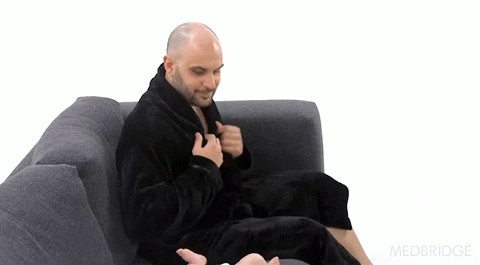How do I hold my baby in the NICU?
An intro to kangaroo care and comforting touch
Feeling unsure about how to hold your baby in the NICU? HAVE NO FEAR, the neonatal therapist is here!!!
In my role at the hospital, I work with babies from about 34 weeks of gestation and beyond. During my initial assessment, I like to congratulate the new parents, check in with how they are adjusting to the NICU, and then dive into specifics about the baby. One of the most important questions I ask is, “have you held your baby?”
Babies in the NICU often face significant medical challenges (especially if they are micro- or nano-preemies), including requiring many lines and wires to monitor their vitals, breathing or feeding tubes, and multiple life-saving surgical procedures. Due to all of these stressors, an absolutely critical piece for a baby’s development—namely, a parent touching and holding their baby—can get missed.
Sure, there can definitely be circumstances where it’s not medically safe or possible to hold your baby. For example, there might be periods of instability where getting the baby out of the isolette or crib is not possible. But no matter what the circumstance, it breaks my heart when parents don’t feel comfortable, empowered, or supported to give their baby that all-important, comforting touch both baby and parent so desperately need. After all, amongst so much uncertainty during a NICU stay, this is one certain way for parents to humanize a medical experience.
Facilitating touch/handing is one of my favorite parts of my job! It’s a way for parents to do parenting things, and babies to do baby things! I have the privilege of supporting parents in this bonding experience with their child. The physiologic benefits that holding, skin-to-skin time, kangaroo care, and comforting touch offer is incredibly powerful. So let’s dive into the why and how of touching and holding your baby in the NICU, and safely get our snuggle on!
Kangaroo care
Kangaroo care, also called skin-to-skin care (SSC), is a term commonly used to describe holding a baby upright on a parent’s chest, with nothing except a diaper (trust me, you want that diaper on!) between the parent’s chest and the baby’s belly. It’s called kangaroo care due to its similarity to the way mama kangaroos hold and carry their joeys. I also love the fact that SSC is rooted in history, tradition, and research.
Mamas, dadas, aunties, uncles and non-gender conforming caregivers from nearly all cultures have been carrying their babies close to their chest for eons. The medical use of kangaroo care was introduced by Edgar Rey Sanabria in Columbia in 1978 as a strategy to replace the function of incubators, which were in short supply at time in the country (Understanding kangaroo care and its benefits to preterm infants; Campbell-Yeo et al, 2015. Pediatric Health Med Ther). The babies were placed on their parent’s chest for SSC continuously, and the impact on both baby and family health was profound.
Since then, the positive effects of kangaroo care have been well-studied and documented in the medical literature. Preterm infants who receive routine kangaroo care are better able to regulate their body temperature and cardiorespiratory stability, have decreased rates of infection, severe illness, and death, and discharge earlier than usual. There are known benefits to support bonding and attachment, reduce maternal anxiety and depression, and create a positive impacts on baby’s neurodevelopmental outcomes.
Video from Medbridge Education
Comforting touch
In the scenario mentioned above, where your baby is not medically stable enough for full on kangaroo care, comforting touch becomes vital. Comforting touch is exactly what it sounds like: touch and input provided to the baby with the goal of providing stress-reducing, pain-relieving, positive, and comforting touch. Many procedures and aspects of daily care in the NICU are painful or negative touch. Heel pokes, taking blood pressure, line changes, manipulating tubes…all of these common and necessary aspects of care often are stress-inducing or painful for the leetle bebes.
Research supports teaching parents (and caregivers, nurses, therapists, neonatologists…basically anyone who interacts with and touches the baby) how to help mitigate some of the negative effects of painful NICU procedures. By safely and regularly providing comforting touch to the baby, we can help promote healing, facilitate sleep, and offer neuroprotective benefits.
Ok, ok, we get it. The benefits are many. But how do we do it??
Ah, I’m glad you asked. I’m going to answer with everyones favorite answer (not): IT DEPENDS. Every baby is different, and providing kangaroo care and comforting touch will look different as well! My instinct based on experience is to tell you AS MUCH AS POSSIBLE, but Feldman et al offers compelling evidence that an hour of kangaroo care per day can have long-lasting benefits.
First and foremost, I recommend working closely with your neonatal therapist, nurses, and the medical team to make holding and touch a priority for your baby. Advocate for SSC when possible, ask for guidance on how to best provide your baby with comforting touch, and know you can be active and involved in each care time!
Your team can help manage lines and tubes, position your baby on your chest, and make sure you both are well supported and comfortable on your kangaroo care journey.
Check out my instagram reel for a few ideas on how to provide comforting touch. Ask your team to help facilitate this. It can look like placing a steady gentle hand on baby’s head during cares. It can include infant massage if directed by your therapist, containment (using your hands to provide comforting physical boundaries with baby in a tucked/flexed position), and giving your baby your finger to grasp. I will share more about these techniques in a future post, so stay tuned! In the meantime, snuggle away!
Follow along @bebe__pt on Instagram for more tips and tricks!
TL;DR
Kangaroo care, or skin-to-skin care, means holding your baby directly to your chest with nothing between the two of you but a diaper (don’t forget the diaper!)
Comforting touch is aimed at providing stress-relieving, pain-reducing, positive touch for your baby.
The benefits of kangaroo care and comforting touch are many, and include reduced stress and pain for baby, improved sleep, bonding and attachment, reduced maternal anxiety and depression, improved physiologic stability, decreased rates of infection, severe illness, and death, and earlier discharge. Did I forget any?
Work with your medical team and neonatal therapist to learn the best, safest, and most effective ways to provide comforting touch and engage in SSC with your little. Generally aim for at least one hour of kangaroo care/day to see the benefits.





